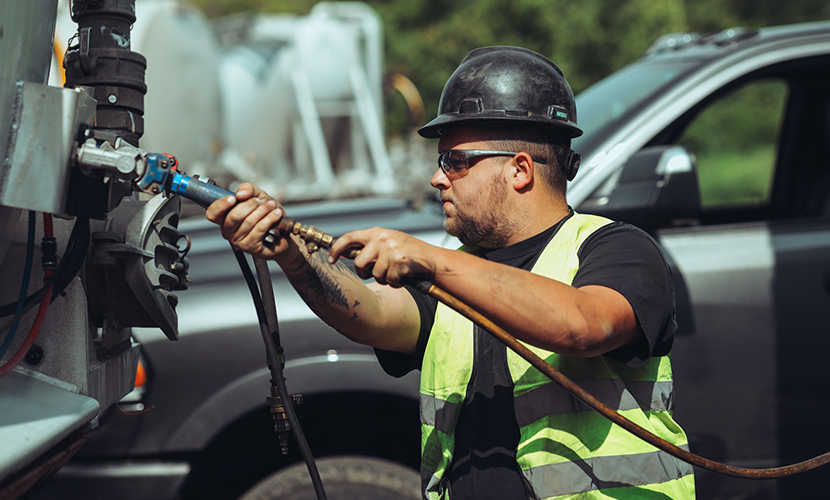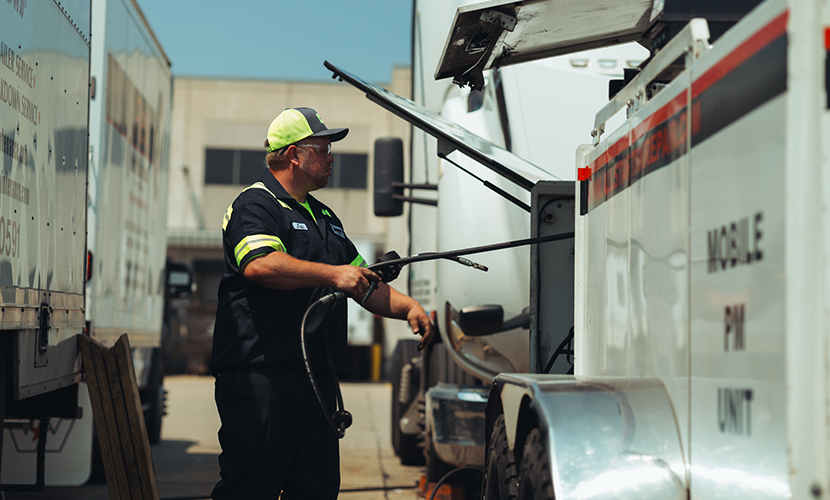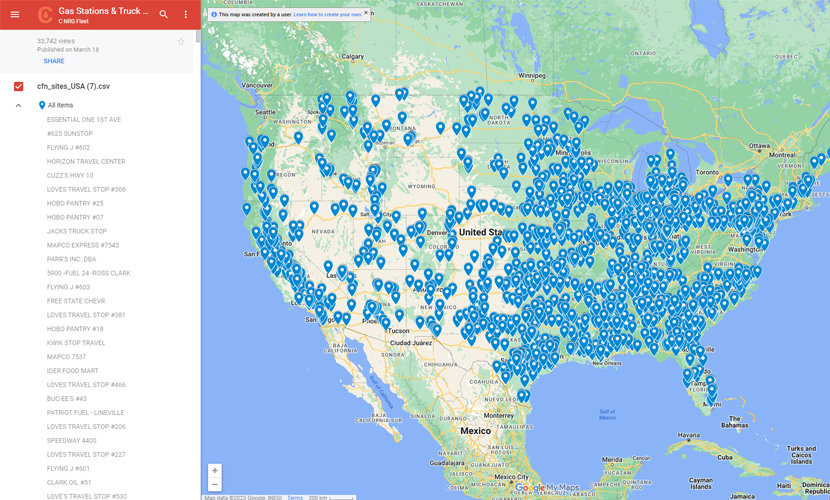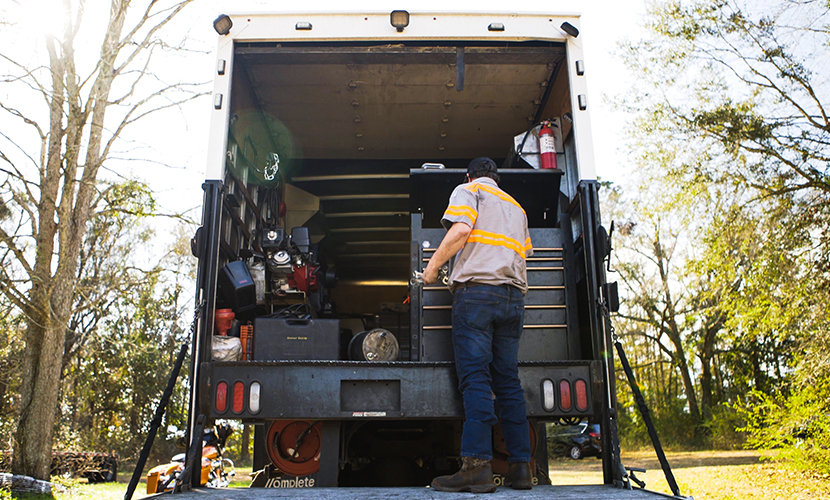Diesel Exhaust Fluid Locator: 5 Ways to Find DEF Near You

Diesel has often been misunderstood in the past. Many people’s impressions of diesel engines are tied to trucks emitting noticeable emissions. However, it’s important to note that these visual emissions are mostly associated with older truck models or those few who modify their trucks to “roll coal” for show.
Thankfully, with advancements in technology and the EPA’s 2010 mandates requiring diesel vehicles to be equipped with an SCR system, which utilizes DEF, the emissions from diesel engines have significantly reduced.
So, let’s dive deeper into what this entails and its implications for fleet managers.
SCR, DEF, and More: What Does it All Mean?
The SCR is the Selective Catalytic Reduction system. It’s a means of converting diesel exhaust into something a lot cleaner, reducing both nitrogen oxide and nitrogen dioxide emissions, both of which are dangerous greenhouse gasses that contribute to a variety of environmental hazards, including acid rain. In fact, the introduction of the SCR system to power generation plants over 50 years ago is a large part of what made acid rain no longer a modern-day concern.
The SCR process is a three-stage system; the engine burns diesel fuel and produces exhaust as a byproduct, and that exhaust is pumped into the SCR:
- It goes through a particulate filter, which traps the larger particles that would otherwise gum up the works.
- Then, DEF is pumped into the exhaust system, and it’s chambered in a catalyzer.
- There, chemical reactions between the nitrogen compounds and the DEF produce nitrogen, water, and a bit of CO2.
All in all, the resulting emissions are significantly less hazardous to both people and the environment and make diesel trucks nigh-infinitely cleaner to run.
“SCR is an active emissions control system. Hot exhaust gasses flow out of the engine and into the SCR system, where aqueous urea (known as Diesel Exhaust Fluid, or DEF) is sprayed onto a special catalyst. The DEF sets off a chemical reaction in the exhaust on a special catalyst that converts nitrogen oxides into nitrogen, water, and tiny amounts of carbon dioxide (CO2), natural components of the air we breathe. The exhaust also passes through a particulate filter somewhere in the system and is then expelled through the vehicle’s tailpipe.
The design of SCR technology is such that it permits nitrogen oxide (NOx) reduction reactions to take place in an oxidizing atmosphere. It is called “selective” because it reduces levels of NOx using ammonia as a reductant within a catalyst system. The chemical reaction is known as “reduction,” where the DEF is the reducing agent that reacts with NOx to convert the pollutants into nitrogen, water, and tiny amounts of CO2. The DEF is rapidly broken down to produce the oxidizing ammonia in the exhaust stream.” – Diesel Forum.
The easiest explaination of this is:
In an SCR, when DEF is added to exhaust gas, it turns into ammonia. This ammonia then reacts with harmful pollutants, transforming them into harmless nitrogen and water, thus reducing harmful emissions.
(If you happened to major in chemistry, you can read a more technical breakdown of how this reaction happens here.)
Of course, fleet managers don’t necessarily need to know the chemical processes behind why DEF works or how the SCR process functions. All you need to know is that the EPA and federal government mandate its use and that DEF is a consumable.
As a consumable, that means diesel engines need to have their DEF tanks refilled from time to time. DEF infrastructure is robust enough that DEF can be found nearly anywhere that diesel fuel is sold. Fortunately, it’s not consumed at a very high rate; DEF generally only needs to be refilled about as often as the engine’s oil is changed,
It’s that “nearly” that gets you, though. DEF can be found in many different locations, but now and then, you run into issues locating it, and that can cause problems. So, how do you locate your nearest – or most efficiently routed – DEF fill-up station?
Note: DEF is essentially a simply balanced solution of urea (commonly and easily purchased) and water, so can’t you make your own? The answer is no. While it’s not difficult to actually make, the urea needs to reach certain minimums of purity, and the water must be pure without contaminants; otherwise, the DEF you produce will damage SCR systems. Moreover, DEF is cheap; buying the ingredients and making it on your own wouldn’t save you anything and would cost you time and effort.
Knowing where to find DEF before your engine runs low is critical because once that tank is dry, the engine shuts off. The last thing you need is a truck stranded because it’s missing a single chemical. So, where can you find DEF near you? Here are five options.
1: Proactive Maintenance: Keep DEF On-Hand
The first option is the one we generally recommend.
Since DEF doesn’t need to be changed and only needs to be topped off occasionally due to its low rate of consumption, you can add “fill the DEF tank” to your preventative maintenance checklist. Then, whenever any of your trucks are in for any kind of inspection, service, or diagnostics, it can be a routine matter to simply top off the DEF tank and call it a day. DEF doesn’t go bad unless it’s been sitting at high temperatures for several years, so as long as your trucks aren’t idle, you don’t need to change out the fluid in the tanks. All you need to do is ensure that it’s topped off, like any other consumable.
If you operate your own service centers or maintenance bays, it’s a simple matter to keep DEF on hand. There are a wide variety of suppliers you can use to order DEF in however large or small a quantity you need, from single-gallon filler jugs to large tanks used for filling up your fleet. You can even order directly from one of the regulated manufacturers of DEF and have it delivered straight to your doors.
On the other hand, if you’re a fleet that uses service centers other than your own, all you need to do is make sure the service and maintenance facilities you use keep DEF on hand. Just about any service provider that works on diesel vehicles with any regularity will keep DEF on hand, so this shouldn’t be a tall order.
At Epika, we have partners all across the country who can help work on and service your fleets, and most of them will have DEF on hand. You can use our “find a service provider” tool to locate nearby service centers with DEF to top off the tank as necessary.
2: Use a Service Provider’s Site Locator
The second option is to use the site locator for a given service provider you know that offers DEF at their service stations.
For example, this page, provided by CNRG Fleet, includes an embedded and robust map of locations for CFN service centers that offer DEF fill-ups as a service they provide. Similarly, using the CFN Locator and selecting DEF under the fuel type offered can show you nearby locations for any truck anywhere in the country you’re operating.
CFN isn’t the only company with DEF services and a station locator, either. Whatever brand loyalty you have, you can pick that brand and find their nearby service centers. They don’t always have robust maps you can check, but you also don’t always need a map if you know ahead of time where the stations you can fill up at are located.
Other options can include Yara or FindDEF.
3: Use a DEF Locator App
These days, just about everyone has a smartphone in their pocket. Even when a driver doesn’t, there’s a reasonable chance that the truck itself is outfitted with a tablet that can do a variety of things, including tracking truck telemetry, identifying and adjusting routes for the driver to take, and monitoring conditions.
Whether your truck technology runs on Google’s Android or Apple’s technology, there are apps available for both platforms that can locate nearby DEF fuel stations. Most trucks will run on some variety of the Android ecosystem, and there are many Google Play Store options available. A variety of different apps with different features are available for locating DEF in nearby locations, using GPS information from the driver’s phone or the truck’s tablet or just an address or general location the operator types in.
Truthfully, an app may not even be necessary. Google’s maps, by default, offers a variety of additional features, and using it to search for nearby DEF locations is going to be a fairly robust, non-app-gated way to find a place to top off the system as necessary.
4: Use a Fleet Management Platform
There are a variety of different apps and platforms available to fleet managers that offer pretty much any service, telemetry, or data tracking options you could want. In addition to allowing you to pick effective, efficient routes for your trucks, dynamically assign nearby drivers to tasks, and optimize the general performance of your fleet, they can also review and predict when trucks may need a top-off of DEF or other ongoing routine maintenance and can direct a driver to a particular service center nearby them that can provide those services.
There are a variety of platforms you can investigate, and picking the one that works best for your fleet is mostly a matter of system architecture and of an app that is intuitive for you and your staff. Options include AUTOsist, Fleetio, Azuga, Onfleet, Samsara, and more.
5: Stock Drivers with Emergency DEF
Another option, which pairs well with option #1 on this list, is to ensure that drivers have a backup supply of DEF on hand. If filling up the DEF tank is missed, or if a bit of tubing springs a leak, or in another emergency where DEF runs low, it can be frustrating – not to mention destructive to productivity and deadlines – for a truck to be rendered non-functional because of a single consumable.
Therefore, it’s easy enough to keep a jug of extra DEF on hand in the general supply kit for a truck. A jug of DEF is cheap – a 2.5-gallon jug is only $10 at Walmart – and it’s readily available. While this shouldn’t be your go-to source of DEF, it’s a good way to ensure that there’s a way to keep a truck moving in an emergency and pairs well with other options to then allow the vehicle to make it to a nearby service center.
Then, when you need to find a nearby service location for an emergency or for routine maintenance, you can consult with us. Epika’s partnerships allow for a wide range of locations for a variety of different services all across the country. You can view our locator, or you can reach out to set up a partnership with us ahead of time.





